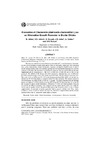Identificador persistente para citar o vincular este elemento:
https://accedacris.ulpgc.es/jspui/handle/10553/106804
| Campo DC | Valor | idioma |
|---|---|---|
| dc.contributor.author | Akbari, M. | en_US |
| dc.contributor.author | Ashrafi, S.S. | en_US |
| dc.contributor.author | Bouyeh, M. | en_US |
| dc.contributor.author | Jáber Mohamad, José Raduán | en_US |
| dc.contributor.author | Seidavi, A. | en_US |
| dc.contributor.author | Rodríguez Ventura, Myriam | en_US |
| dc.date.accessioned | 2021-04-14T12:57:20Z | - |
| dc.date.available | 2021-04-14T12:57:20Z | - |
| dc.date.issued | 2020 | en_US |
| dc.identifier.issn | 0972-2963 | en_US |
| dc.identifier.uri | https://accedacris.ulpgc.es/handle/10553/106804 | - |
| dc.description.abstract | This study was conducted to evaluate Matricaria chamomilla (MC), commonly known as chamomile, as a new growth promoter in broiler chicks and its effects on feed intake, weight gain, feed conversion ratio, carcass characteristics, clinical biochemistry, immunity and digestive bacterial count. A total of 200 day-old male broiler chicks were randomly assigned into five experimental treatments each with four replicates of 10 chicks. The treatments were feeding of commercial diet as a control (CD) and the same supplemented with M. chamomilla at 0.3 (MC-0.3), 0.6 (MC-0.6), 0.9 (MC-0.9) and 1.2 (MC-1.2) per cent levels. The addition of MC did not affect feed consumption. Although there were no differences (P>0.05) among the groups at any of the periods in the feed intake, BW gain and feed conversion ratio. There were, however, differences (P<0.05) in the European production index (EPI) with the index for chickens fed MC-0.6 being higher as compared with all the other treatments. The immune response to Newcastle disease was higher in MC-0.9 and MC-1.2 groups. The counts of lactobacilli in the intestinal digesta were higher (P<0.05) in broilers receiving MC-0.6 and MC-0.9 diets than those fed on the CD diet. In respect of plasma clinical biochemistry, differences (P<0.05) were found in glucose, HDL and uric acid for the different treatments when compared with the control, but the values were within the normal range for poultry. Overall, the present study indicates that the positive effects, if any, of dietary supplementation of chamomile in broilers apparently failed to present a definite trend. Thus, further evaluation is needed in order to establish the proper use, the level of supplementation and the potential beneficial effects that M. chamomilla would impart in broilers. | en_US |
| dc.language | eng | en_US |
| dc.relation.ispartof | Animal Nutrition and Feed Technology | en_US |
| dc.source | Animal Nutrition and Feed Technology [ISSN 0972-2963], n. 20, p. 71-81 | en_US |
| dc.subject | 310906 Nutrición | en_US |
| dc.subject.other | Broiler chicks | en_US |
| dc.subject.other | Clinical biochemistry | en_US |
| dc.subject.other | Growth promoter | en_US |
| dc.subject.other | Matricaria chamomilla | en_US |
| dc.title | Evaluation of Chamomile (Matricaria chamomilla L.) as an Alternative Growth Promoter in Broiler Chicks | en_US |
| dc.type | info:eu-repo/semantics/Article | en_US |
| dc.type | article | en_US |
| dc.identifier.doi | 10.5958/0974-181X.2020.00007.4 | en_US |
| dc.identifier.issue | 1 | - |
| dc.investigacion | Ciencias de la Salud | en_US |
| dc.type2 | Artículo | en_US |
| dc.utils.revision | Sí | en_US |
| dc.identifier.ulpgc | Sí | en_US |
| dc.contributor.buulpgc | BU-MED | en_US |
| dc.description.sjr | 0,153 | |
| dc.description.jcr | 0,227 | |
| dc.description.sjrq | Q4 | |
| dc.description.jcrq | Q4 | |
| dc.description.scie | SCIE | |
| item.fulltext | Con texto completo | - |
| item.grantfulltext | open | - |
| crisitem.author.dept | GIR Anatomía Aplicada y Herpetopatología | - |
| crisitem.author.dept | Departamento de Morfología | - |
| crisitem.author.dept | GIR IUIBS: Nutrición | - |
| crisitem.author.dept | IU de Investigaciones Biomédicas y Sanitarias | - |
| crisitem.author.dept | Departamento de Patología Animal, Producción Animal, Bromatología y Tecnología de Los Alimentos | - |
| crisitem.author.orcid | 0000-0001-6413-3230 | - |
| crisitem.author.orcid | 0000-0001-9037-2577 | - |
| crisitem.author.parentorg | Departamento de Morfología | - |
| crisitem.author.parentorg | IU de Investigaciones Biomédicas y Sanitarias | - |
| crisitem.author.fullName | Jáber Mohamad, José Raduán | - |
| crisitem.author.fullName | Rodríguez Ventura, Myriam | - |
| Colección: | Artículos | |
Los elementos en ULPGC accedaCRIS están protegidos por derechos de autor con todos los derechos reservados, a menos que se indique lo contrario.
